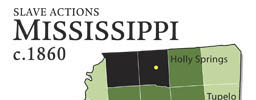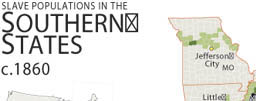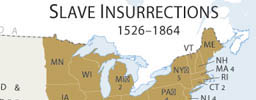A Map of Slave Revolts in the United States

A number of slave actions in Mississippi are cluster where the Mississippi river where the majority of enslaved population lived on large plantations. In many of these countries enslaved Africans outnumbered whites 9 to 1. Mississippi was settled by the French in the 1720s. The French brutally put down a revolt of Natchez Indians and enslaved Africans in 1726, the state functioned as the western terminus of the domestic slave trade in the decades before the Civil War. The second largest slave market in the lower South was located in Natchez. Thousands of enslaved Africans were transported to the Natchez market for sale. The majority of enslaved Africans in Mississippi worked in the production of cotton as field hands. Several thousand worked and lived in urban centers such  as Natchez, Jackson, Vicksburg and Columbus as domestic and house servants. In 1830 1,366 Blacks were free persons of color working mostly as skilled tradesmen and small farmers and about twelve free blacks were slave owners. A number of slave actions in Mississippi are cluster where the Mississippi river where the majority of enslaved population lived on large plantations. In many of these countries enslaved Africans outnumbered whites 9 to 1. Mississippi was settled by the French in the 1720s. The French brutally put down a revolt of Natchez Indians and enslaved Africans in 1726, the state functioned as the western terminus of the domestic slave trade in the decades before the Civil War. The second largest slave market in the lower South was located in Natchez.
as Natchez, Jackson, Vicksburg and Columbus as domestic and house servants. In 1830 1,366 Blacks were free persons of color working mostly as skilled tradesmen and small farmers and about twelve free blacks were slave owners. A number of slave actions in Mississippi are cluster where the Mississippi river where the majority of enslaved population lived on large plantations. In many of these countries enslaved Africans outnumbered whites 9 to 1. Mississippi was settled by the French in the 1720s. The French brutally put down a revolt of Natchez Indians and enslaved Africans in 1726, the state functioned as the western terminus of the domestic slave trade in the decades before the Civil War. The second largest slave market in the lower South was located in Natchez.  Thousands of enslaved Africans were transported to the Natchez market for sale. The majority of enslaved Africans in Mississippi worked in the production of cotton as field hands. Several thousand worked and lived in urban centers such as Natchez, Jackson, Vicksburg and Columbus as domestic and house servants. In 1830 1,366 Blacks were free persons of color working mostly as skilled tradesmen and small farmers and about twelve free blacks were slave owners.
Thousands of enslaved Africans were transported to the Natchez market for sale. The majority of enslaved Africans in Mississippi worked in the production of cotton as field hands. Several thousand worked and lived in urban centers such as Natchez, Jackson, Vicksburg and Columbus as domestic and house servants. In 1830 1,366 Blacks were free persons of color working mostly as skilled tradesmen and small farmers and about twelve free blacks were slave owners.
Throughout the American South there appears to be a relationship to the number of enslaved Africans in a given area and the number of slave actions. Where enslaved Africans were cluster into numbers of 10,000 or higher. The enslaved population density in a given area also contributed to the likely hood of slave insurrections. Between 1790 and 1860 slave population in the U.S. increased from 698,000 to 3,954, 00. The large numbers of enslaved Africans in a given area also created a “critical mass,” which seemed a necessary element and pre-condition for slave insurrection. Also the type of labor enslaved Africans were forced into also contributed. The majority of enslaved Africans worked in cotton. About 15 percent of southern slaves were as domestic servants and ten percent worked in commerce, trades, and industry primarily in the urban centers. The slave population map shows the heavy concentration of enslaved Africans lived on plantations of between 20 to 150 enslaved Africans. These heavy concentrations of enslaved Africans population are historically known as the “Black Belt”—slave states from Virginia to Texas. In some of these areas, enslaved blacks outnumbered whites 13 to 1. There was more primary type of revolts areas where the slave population was 10,000 or greater.
Although there were many incidents of organized slave rebellion, only a few hundred are documented with reliable evidence. This map show where were at least 313 slave actions, or alleged revolts by groups of ten or more slave, took place as reported in official records and newspaper accounts.
